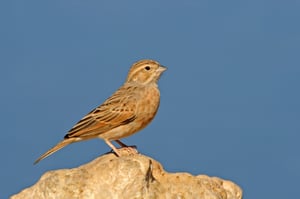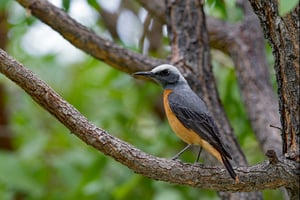BIRDING
IN NAMIBIA
IN NAMIBIA
Here you will be able to meet the vast and colourful bird life inhabiting the areas in and around all Gondwana Collection properties. As you might already know Namibia is home to 681 bird species.
So keep in mind this is not a complete list, YET...
Fill out the form to receive a FREE pdf download with 125 birds listed.
The Kalahari Experience
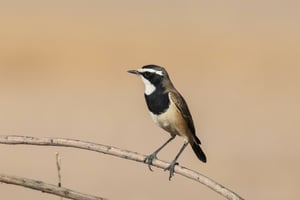
CAPPED WHEATEAR
Introduction: Capped wheatears (Oenanthe pileata) often inhabit dry grassy plains, semi-arid shrublands and freshly harvested crop lands, usually singly or in pairs. Perching locations include fence posts, wires, bushes, stones and termite mounds. Often fall prey to the black-footed cat.
Size: 17cm.
Weight: 24g.
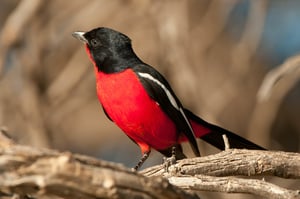
CRIMSON-BREASTED SHRIKE
Introduction: Crimson-breasted shrikes (Laniarius atrococcineus) are very active and agile birds, found singly or in terrestrial pairs in Kalahari thornveld, Acacia savannah and dry scrubland with some clusters of small trees. Roosting on the mid to lower branches is preferred, especially on a sickle-bush.
Size: 22cm.
Weight: 50g.
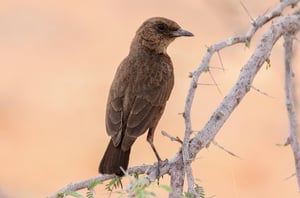
ANT-EATING CHAT
Introduction: Ant-eating chats (Myrmecocichla formicivora) prefer habitats that include dwarf shrub savannah, open grasslands and some regions of mountain or mopane savannah. They can be observed singly or in pairs, (or small groups of up to 6) at times roosting in nest holes.
Size: 18cm.
Weight: Up to 50g
Accommodation in the Area
Kalahari Anib Lodge | Kalahari Farmhouse | Kalahari Anib Camping2Go | Kalahari Anib Campsite
The Fish River Canyon Experience
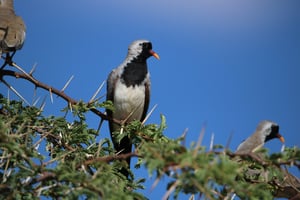
NAMAQUA DOVE
Introduction: Namaqua doves (Oena capensis) can be found in almost every habitat including dry woodlands, arid and semi-arid shrub lands, riverine woodlands in desert regions, farmyards and gardens. They are usually alone or in pairs, congregating at water holes to drink either side of mid-day
Size: 25cm.
Weight: 40g.
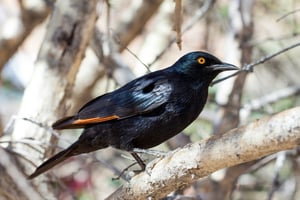
PALE-WINGED STARLING
Introduction: Although pale-winged starlings (Onychognathus nabouroup) are dependent on rocky hills or valleys for breeding and roosting sites, towns also attract this species, mainly for them to search for food. Flocks or small parties are the norm, as is drinking and bathing regularly
Size: 26cm.
Weight: 100g.
Accommodation in the Area
Canyon Roadhouse | Canyon Roadhouse Campsite | Canyon Village | Canyon Lodge
The Namib Experience
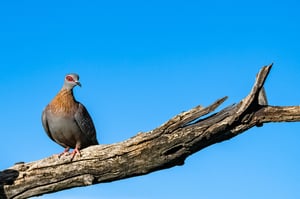
SPECKLED PIGEON
Introduction: Speckled pigeons (Columba guinea) or rock pigeons can be found in a variety of habitats including urban and rural areas, mountains, cliffs, rocky gorges and boulder-strewn hills. Flocks of up to 20 are not uncommon and roosting on cliff ledges, on buildings and in caves as well as on trees is a behavioural feature
Size: 33cm.
Weight: 350g.
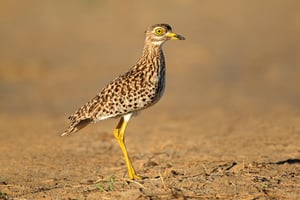
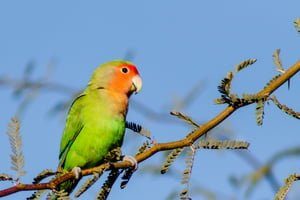
ROSY-FACED LOVEBIRD
Introduction: Rosy-faced lovebirds (Agapornis roseicollis) prefer open and wooded country which includes semi-desert shrub lands, cultivated lands and riparian woodlands, environments that are dependable on water. A noisy and gregarious bird, they congregate small flocks of up to 20. Roosts in sociable weavers nest
Size: 18cm.
Weight: 55g.
Accommodation in the Area
Namib Desert Lodge | Namib Desert Camping2Go | Namib Desert Campsite | Namib Dune Star Camp | Desert Whisper | Desert Grace
The Damaraland Experience


RUPPEL’S PARROT
Introduction: Rüppell's parrot (Poicephalus rueppellii) is named after Wilhelm Rüppell (1794-1884), the German naturalist, collector and explorer. They inhabit mature riparian woodland along ephemeral rivers and northern lala palms along the Kunene River, where they spend most of their time. Flocks of 20 are common and they roost in holes in tall trees
Size: 25cm.
Weight: 115g.
Accommodation in the Area
Damara Mopane Lodge | Palmwag Lodge & Camp | Palmwag Camping2Go | Palmwag Campsite
The Etosha Experience

AFRICAN SCOPS OWL
Introduction: African scops-owls (Otus scops-owl) inhabit arid savannah woodland especially mopane woodland and acacia parklands that extend along watercourses into grassland and desert. Absent from true desert and treeless grassland. Nocturnal but roosts by day tucked against a branch or tree-trunk. Emerges just after dark or late dusk, eyes wide open ready to hunt
Size: 18cm.
Weight: 65g.
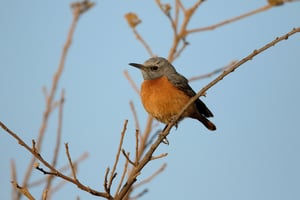
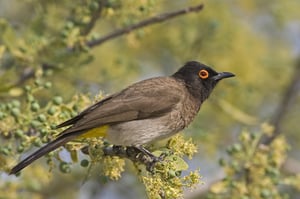
AFRICAN RED-EYED BULBUL
Introduction: African red-eyed bulbul (Pycnonotus nigricans) can be observed in a wide range of habitats that include arid and semi-arid regions, as long as there is water and patches of trees and shrubs. This includes dry woodland, riverine bush and shrubby watercourses. They are a common visitor to gardens in drier regions of Namibia, usually grateful for a full bird bath to drink from
Size: 20cm.
Weight: 30g.
Accommodation in the Area
Etosha Safari Lodge | Etosha Safari Camp | Etosha Safari Camping2Go | Etosha Safari Campsite | Etosha King Nehale
The Okavango Experience
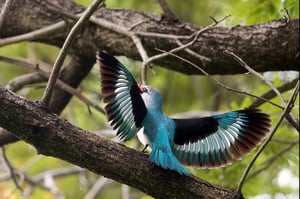
WOODLAND KINGFISHER
Introduction: Woodland kingfishers (Halcyon senegalensis) originate from Senegal and inhabit wooded savannahs with fresh water. They can be observed in well-developed wooded areas with tall riverine trees such as Acacia stands and mopane. Their presence in man-altered habitats is well documented. Low flying, direct, fast and usually in pairs, they are a strongly territorial species that perch and trill on tree tops, singing throughout the day
Size: 24 cm.
Weight: 65g.
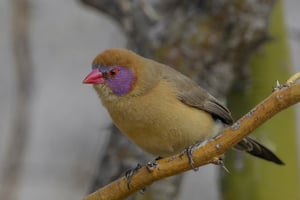
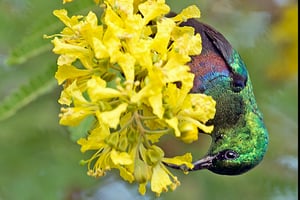
MARICO SUNBIRD
Introduction: Dry Acacia savannah, broad-leaved woodland with river thorn and forest fringing swampland are the preferred habitat of the Marico sunbird (Cinnyris mariquensis). Although they are often observed singly or in pairs, they often gather in mixed flocks with other nectar-seeding sunbirds
Size: 11cm.
Weight: 11g.
Accommodation in the Area
The Zambezi Experience
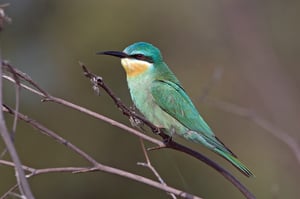
BLUE-CHEEKED BEE-EATER
Introduction: Blue-cheeked bee-eaters (Merops persicus) prefer desert-edged habitats which include breeding in sandy and gravelly type waste grounds. They can also be seen in open lake shores with papyrus and reeds, coastal plains and wooded swamps. These bee-eaters are seldom far from water
Size: 26cm.
Tail streamers project a further 55mm.
Weight: 50g.
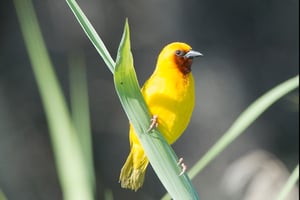
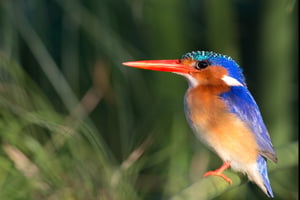
MALACHITE KINGFISHER
Introduction: Malachite kingfishers (Alcedo cristata) depend on a specifically aquatic habitat which could include well-vegetated, slow-flowing rivers and streams, and in particular those waterways that do not have an overhanging tree canopy. They are also found on dams, coastal lagoons, tidal estuaries, sheltered shorelines, mangrove swamps, irrigation canals and sewage ponds. Wooded banks with nearby thickets and reed and papyrus marshes are also a favourite
Size: 14cm.
Weight: 17g.
Accommodation in the Area
Namushasha River Lodge | Namushasha River Camping2Go | Namushasha River Campsite | Namushasha River Villa | Zambezi Mubala Lodge | Zambezi Mubala Camp | Zambezi Mubala Campsite | Chobe River Camp | Chobe River Campsite

